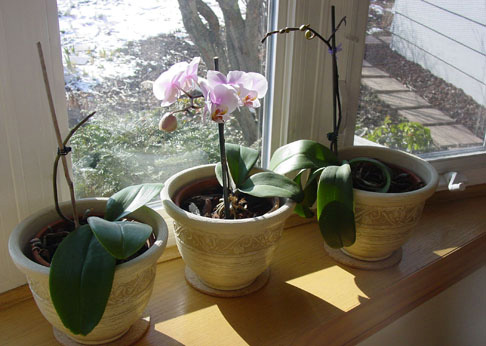I have grown many different houseplants throughout the years, but had always resisted growing orchids. I thought of them as being beautiful, tropical but difficult to grow. The orchids I admired in our local garden center were not cheap and I had no confidence that I could really keep one alive in my home, let alone get it to rebloom.
All that changed when I was given a “rescue orchid” found in the trash by my friend. Knowing that I usually have a “green thumb” my friend asked if I would give her orphan a home and maybe get it to bloom again. I had absolutely no idea if I could provide the right growing conditions for the orphan, but I decided to try. I put the rescue plant, which turned out to be a Moth Orchid (Phalaenopsis), under a potted palm located about 10 feet from a window in our home. I watered it once a week with the rest of my plants and it did nothing for a solid year — it didn’t die, it didn’t grow and it certainly didn’t bloom.
However, the next summer when we replaced our old picture window, we added a window seat area to the living room. Then, while redecorating the living room, I decided the window seat was a perfect spot to grow a few plants and I moved my moth orchid to its new home. After only a month in the brighter light, my orphan sent up a flower spike that bloomed for at least 4 months. I was so excited by my success that I went on to acquire a lot more orchids.
In reading about orchids, I found out that moth orchids are some of the most common, longest-blooming orchids available. One bloom spike can look great for four months or more and their flowers come in many colors — white, pink, red, green, yellow, orange, and purple. My orchids all love the bright spot in our window and each plant blooms at least once a year. I now have orchids blooming most of the time and I move them around the house to enjoy their blooms. Moth orchids have become my favorite indoor plants and occasionally I even use them as special gifts.
Research: Tips for growing Moth Orchids:
Light Requirement: All orchids need good light, but they cannot stand a lot of heat. You can reduce temperatures in south or west-facing summer windows by drawing sheer curtains across them or moving your plants to an east window. In my case, I have a small Hawthorne tree growing outside my west facing window, so during winter we get full sun and in summer the tree provides dappled light. It seems to be the perfect answer.
Water: Orchids should be potted in a special orchid mix made of bark chunks and not allowed to dry out completely between waterings. Always use room temperature or barely lukewarm water that will not shock the orchids’ roots, and avoid softened water if at all possible.
I usually place my orchid into a bowl of water about 2 inches deep and then pour more water on top. After a couple of minutes, I move the plant to the sink and let all of the excess moisture drain off. (This drainage step is very important because orchids will not tolerate soggy roots).
Fertilizer: You can promote more and larger blooms by feeding moth orchids monthly with a fertilizer formulated for orchids.
Temperature: These plants do best in temperatures from 50 to 75F and orchids may fail to bloom if night temperatures are very close to daytime levels. A two-week period in spring or fall where temperatures at night are kept ten to fifteen degrees cooler than days should spur flower development, if your plant gets enough light.




